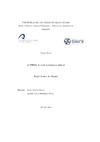Please use this identifier to cite or link to this item:
https://accedacris.ulpgc.es/jspui/handle/10553/10579
| DC Field | Value | Language |
|---|---|---|
| dc.contributor.advisor | Cabrera Gámez, Jorge | - |
| dc.contributor.advisor | Domínguez Brito, Antonio Carlos | - |
| dc.contributor.author | Ramos De Miguel, Ángel | - |
| dc.date.accessioned | 2013-07-26T10:37:04Z | |
| dc.date.accessioned | 2018-05-15T10:47:21Z | - |
| dc.date.available | 2013-07-26T10:37:04Z | |
| dc.date.available | 2018-05-15T10:47:21Z | - |
| dc.date.issued | 2013 | en_US |
| dc.identifier.uri | https://accedacris.ulpgc.es/handle/10553/10579 | |
| dc.description | Máster Universitario en Sistemas Inteligentes y Aplicaciones Numéricas en Ingeniería (SIANI) | en_US |
| dc.description.abstract | This master thesis describes the development of the A-TIRMA, an au- tonomous sailboat based on an One Meter Class RC vessel. The A-Tirma navigates autonomously with no human intervention except for establishing the route it will follow. One of the distinctive features of sailing robots is that they constitute really interesting operative platforms for monitoring and data sampling in aquatic environments, mainly due to its low power consumption requirements which allows them great operative autonomy. In addition, in the case of A-TIRMA, it is also easily deployable due to its small size and weight. The control system of A-TIRMA consists of two main parts: a base sta- tion and the sailboat. From the base station (a notebook) we can command straightly the sailboat’s sails and rudder remotely in RC (Remote Control) mode using a wireless link. In autonomous mode, we can make the boat to follow autonomously a route, which is a list of waypoints specified on a Google Maps interface. The boat is endowed with an embedded on board system, which, in autonomous mode, bases its operation in an autonomous fuzzy-logic based navigation algorithm for controlling the boat’s sails and rudder, in order to navigate autonomously following the route of waypoints specified from the base station. During its development we have made in- tensive sea trials to check the operational capabilites of A-TIRMA and its control system at sea, and its autonomy in terms of power consumption and operative endurance. | en_US |
| dc.language | spa | en_US |
| dc.subject | 120304 Inteligencia artificial | en_US |
| dc.subject.other | Autonomous | en_US |
| dc.subject.other | Sailboat | en_US |
| dc.subject.other | ASV | en_US |
| dc.title | A-TIRMA: A small autonomous sailboat | en_US |
| dc.type | info:eu-repo/semantics/masterThesis | en_US |
| dc.type | MasterThesis | en_US |
| dc.compliance.driver | 1 | es |
| dc.contributor.centro | IU Sistemas Inteligentes y Aplicaciones Numéricas | en_US |
| dc.contributor.facultad | Escuela de Ingeniería Informática | en_US |
| dc.identifier.absysnet | 686174 | |
| dc.identifier.crisid | 41297 | |
| dc.investigacion | Ingeniería y Arquitectura | en_US |
| dc.rights.accessrights | info:eu-repo/semantics/openAccess | es |
| dc.type2 | Trabajo final de máster | en_US |
| dc.utils.revision | Sí | en_US |
| dc.identifier.matricula | TFT-28578 | es |
| dc.identifier.ulpgc | Sí | en_US |
| dc.contributor.titulacion | Máster Universitario en Sistemas Inteligentes y Aplicaciones Numéricas en Ingeniería | es |
| item.fulltext | Con texto completo | - |
| item.grantfulltext | open | - |
| crisitem.advisor.dept | GIR SIANI: Inteligencia Artificial, Robótica y Oceanografía Computacional | - |
| crisitem.advisor.dept | IU Sistemas Inteligentes y Aplicaciones Numéricas | - |
| crisitem.advisor.dept | Departamento de Informática y Sistemas | - |
| crisitem.advisor.dept | GIR SIANI: Inteligencia Artificial, Robótica y Oceanografía Computacional | - |
| crisitem.advisor.dept | IU Sistemas Inteligentes y Aplicaciones Numéricas | - |
| crisitem.advisor.dept | Departamento de Informática y Sistemas | - |
| crisitem.author.dept | GIR SIANI: Modelización y Simulación Computacional | - |
| crisitem.author.dept | IU Sistemas Inteligentes y Aplicaciones Numéricas | - |
| crisitem.author.orcid | 0000-0002-0528-815X | - |
| crisitem.author.parentorg | IU Sistemas Inteligentes y Aplicaciones Numéricas | - |
| crisitem.author.fullName | Ramos De,Ángel | - |
| Appears in Collections: | Trabajo final de máster | |
Page view(s)
221
checked on Feb 22, 2025
Download(s)
210
checked on Feb 22, 2025
Google ScholarTM
Check
Share
Export metadata
This item is licensed under a Creative Commons License

